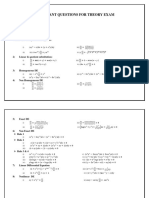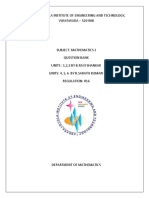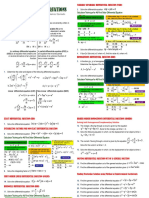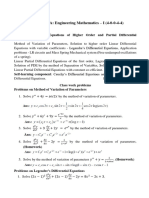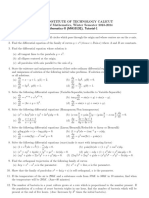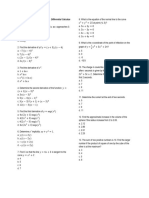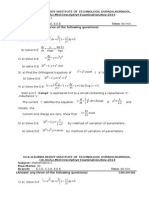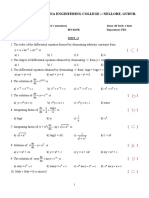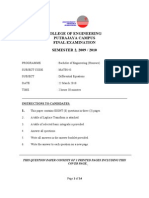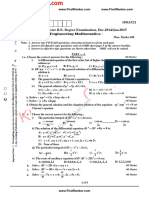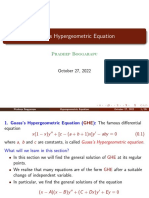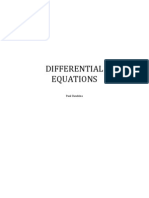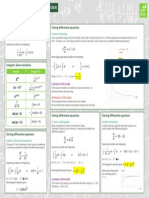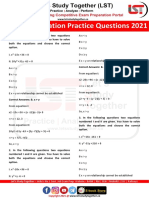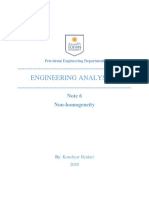Department of Mathematics PRACTICE SET 4
Program B. Tech. (SoCS/SoAE) Semester I
Course Advanced Engineering Course Code MATH1059
Mathematics I
Session July-Dec 2024 Unit (IV & V) Linear Differential Equations
with Visualizations; Non-
linear Differential Equations
with Visualizations
1. Define linear and non-linear ordinary differential equations. State with reason the
following differential equations are linear or non-linear.
𝑑2 𝑦 𝑑𝑦
(i) + 𝑥 2 𝑑𝑥 + 𝑥 sin 𝑦 = 0.
𝑑𝑥 2
𝑑2 𝑦 𝑑𝑦
(ii) + 5(𝑥 + 𝑦)2 𝑑𝑥 + 6𝑦 = 0.
𝑑𝑥 2
2
2𝑑 𝑦 𝑑𝑦
(iii) 𝑥 − 𝑥 𝑑𝑥 + 𝑦 = 1 − log 𝑒 𝑥, (𝑥 > 0).
𝑑𝑥 2
2. (i) Find the value of 𝜆 for which the differential equation
(3𝑥 2 + 𝜆𝑒 𝑦 )𝑑𝑥 + (2𝑥𝑒 𝑦 + 3𝑦 2 )𝑑𝑦 = 0,
is exact.
(ii) Determine the values of 𝑎 and 𝑏 for which the differential equation
1
(𝑎𝑥 2 𝑦 + 𝑦 3 )𝑑𝑥 + ( 𝑥 3 + 𝑏𝑥𝑦 2 ) 𝑑𝑦 = 0,
3
is exact, and then solve it in the case of those values of 𝑎 and 𝑏.
3. Show that the given equations are not exact but becomes exact when multiplied by
the given integrating factor (𝐼. 𝐹. ).
𝑦3 𝑥2 1
(a) (𝑦 + + ) 𝑑𝑥 + 4 (𝑥 + 𝑥 𝑦 2 )𝑑𝑦 = 0, (𝐼. 𝐹. ) = 𝑥 3 .
3 2
(b) (cos 𝑦 sin 2𝑥)𝑑𝑥 + (cos 2 𝑦 − cos2 𝑥)𝑑𝑦 = 0 , (𝐼. 𝐹. ) = (sec 𝑦 + tan 𝑦) sec 𝑦.
(c) (𝑦 2 𝑥 − 𝑥 2 )𝑑𝑥 + (3𝑥 2 𝑦 2 + 𝑥 2 𝑦 − 2𝑥 3 + 𝑦 2 )𝑑𝑦 = 0 , (𝐼. 𝐹. ) = 𝑒 6𝑦 .
4. Is the integrating factor of any solvable non-exact differential equation unique? Justify
your answer with at least an example.
5. If 𝑀(𝑥, 𝑦)𝑑𝑥 + 𝑁(𝑥, 𝑦)𝑑𝑦 = 0 and 𝑃(𝑥, 𝑦)𝑑𝑥 + 𝑄(𝑥, 𝑦)𝑑𝑦 = 0 are exact differential
equations, the show that (𝑀 + 𝑃)𝑑𝑥 + (𝑁 + 𝑄)𝑑𝑦 = 0 is also an exact differential
equation.
6. Solve the following differential equations.
𝑥 𝑥
𝑥
(a) (1 + 𝑒 𝑦 ) 𝑑𝑥 + 𝑒 𝑦 {1 − ( )} 𝑑𝑦 = 0.
𝑦
2 2
(b) (𝑦 2 𝑒 𝑥𝑦 + 4𝑥 3 )𝑑𝑥 + (2𝑥𝑦𝑒 𝑥𝑦 − 3𝑦 2 )𝑑𝑦 = 0.
(c) 𝑦 sin 2𝑥𝑑𝑥 − (1 + 𝑦 2 + cos 2 𝑥)𝑑𝑦 = 0.
(d) (cos 𝑥 + 𝑦 sin 𝑥)𝑑𝑥 = (cos 𝑥)𝑑𝑦, 𝑦(𝜋) = 0.
�Department of Mathematics PRACTICE SET 4
7. Examine whether the following differential equations are exact or not. If not exact,
made it exact and hence solve.
1
(a) (𝑥𝑦 2 − 𝑒 𝑥3 ) 𝑑𝑥 − 𝑥 2 𝑦𝑑𝑦 = 0.
(b) (3𝑥 2 𝑦 4 + 2𝑥𝑦)𝑑𝑥 + (2𝑥 3 𝑦 3 − 𝑥 2 )𝑑𝑦 = 0.
(c) (𝑥 4 + 𝑦 4 )𝑑𝑥 − 𝑥𝑦 3 𝑑𝑦 = 0.
8. Solve the following differential equations (𝐷 stands for 𝑑⁄𝑑𝑥 ):
(a) (2𝐷2 − 2𝐷 − 1)𝑦 = 0.
(b) (𝐷3 − 5𝐷2 + 7𝐷 − 3)𝑦 = 0.
(c) (𝐷4 − 6𝐷3 + 12𝐷2 − 8𝐷)𝑦 = 0.
(d) (𝐷3 + 1)𝑦 = 0.
9. Solve the following differential equations (𝐷 stands for 𝑑⁄𝑑𝑥 ):
(a) (𝐷2 − 4)𝑦 = 𝑒 2𝑥 + 𝑒 −4𝑥 .
(b) (𝐷2 + 1)𝑦 = sin 𝑥 sin 2𝑥.
(c) (𝐷4 − 2𝐷3 + 𝐷2 )𝑦 = 𝑥 3 .
(d) (𝐷2 + 2)𝑦 = 𝑥 3 + 𝑥 2 + 𝑒 −2𝑥 + cos 3𝑥.
10. Define Wronskian. Evaluate Wronskian of the functions 𝑦1 (𝑥) = sin 𝑥 and
𝑦2 (𝑥) = sin 𝑥 − cos 𝑥.
11. A condenser of capacity 𝐶 discharged through an inductance 𝐿 and resistance 𝑅 in
𝑑2 𝑞 𝑑𝑞 𝑞
series and the charge 𝑞 at time 𝑡 satisfies the equation 𝐿 𝑑𝑡 2 + 𝑅 𝑑𝑡 + 𝐶 = 0. Given
that 𝐿 = 0.25 ℎ𝑒𝑛𝑟𝑖𝑒𝑠, 𝑅 = 250 𝑜ℎ𝑚𝑠, 𝐶 = 2 × 10−6 𝑓𝑎𝑟𝑎𝑑𝑠, and that when
𝑑𝑞
𝑡 = 0 charge 𝑞 is 0.002 𝑐𝑜𝑢𝑙𝑜𝑚𝑏𝑠 and the current = 0, obtain the value of 𝑞 in
𝑑𝑡
terms of 𝑡.
𝑑2 𝑞 𝑞
12. The differential equation 𝐿 𝑑𝑡 2 + 𝐶 = 𝐸 sin 𝑛𝑡 represents the equation for electric charge
𝑞 of an electric circuit consisting of an inductance 𝐿, capacitance, 𝐶 and an emf 𝐸 sin 𝑛𝑡
applied in series. Initially, there is no current and charge on the condenser. Prove that the
current 𝑖 is given by
𝑛𝐸
𝑖= (cos 𝜔𝑡 − cos 𝑛𝑡),
𝐿(𝑛2 − 𝜔 2 )
1 𝐸𝑡
where 𝜔2 = 𝐿𝐶. If 𝑛 = 𝜔, prove that 𝑖 = 2𝐿 sin 𝜔𝑡.
13. Write the solution of the initial-value problem
𝑑𝑃 𝑃
= 0.08𝑃 (1 − 1000) 𝑃(0) = 100
𝑑𝑡
and use it to find the population sizes 𝑃(40) and 𝑃(80). At what time does the population
reach 900?
�Department of Mathematics PRACTICE SET 4
14. Biologists stocked a lake with 400 fish and estimated the carrying capacity (the maximal
population for the fish of that species in that lake) to be 10,000. The number of fish tripled
in the first year.
(i) Assuming that the size of the fish population satisfies the logistic equation
𝑑𝑃 𝑃
= 𝑟𝑃 (1 − ),
𝑑𝑡 𝑁
find an expression for the size of the population after t years.
(ii) How long will it take for the population to increase to 5000?
15. A competitive interaction is described by the Lotka-Volterra competition model
𝑥 ′ (𝑡) = 0.01𝑥(100 − 𝑥 − 𝑦),
𝑦 ′ (𝑡) = 0.05𝑦(60 − 𝑦 − 0.2𝑥).
Find all critical points of the system.

